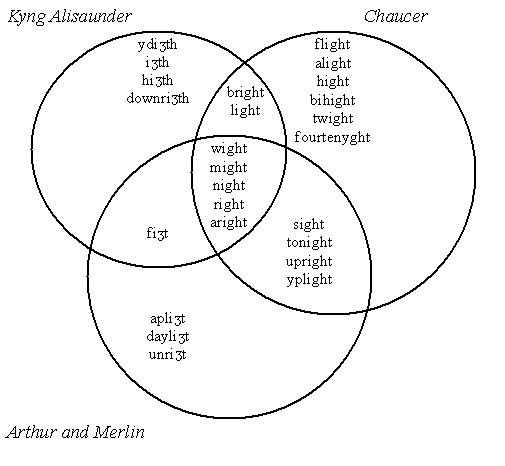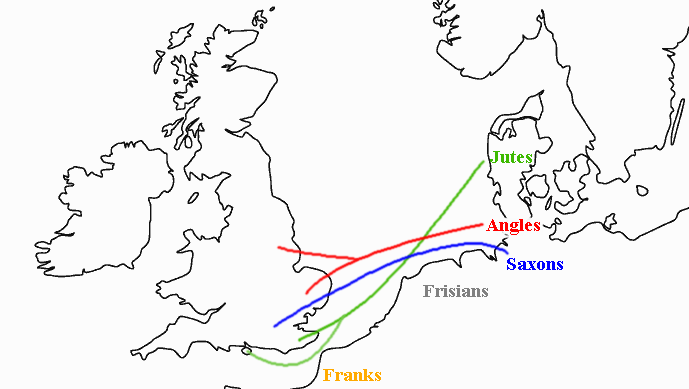2011-05-08 Sun
■ #741. 従属接続詞としての and [conjunction][kyng_alisaunder][but]
and は現代英語で最頻の接続詞である.BNC の頻度リストによると,全語彙中,堂々第4位の頻度を誇る (Frequency Sorter) .現在ではもっぱら等位接続詞 (coordinate conjunction) として機能するが,古い英語では従属接続詞 (subordinate conjunction) として,より具体的には if と同等の条件の接続詞 として用いられていたことは,あまり知られていない.例えば,and it please you と言えば if you please を意味した.
OED では,and, conj.1 の C の項で,この用法が取りあげられている.MED では and (conj. (& adv.)) の 5 で扱われている.and if ( = if ) や and but if ( = but if ) の組み合わせで用いられることもある (Mustanoja, p. 469) .弱形の an も1600年頃に現われる.
and のこの用法の起源は不詳である.Middle High German の unde や Old Norse の enda に対応する用法があるが,英語のものはこれらの言語からの影響というよりは独立の発達と考えるほうが妥当なようだ.後期古英語あるいは初期中英語より用いられていたが,現在は廃用となっている.中英語の用例は上記の MED のページを参照してもらうとよいが,Kyng Alisaunder から拾い集めた例が特に分かりやすいと思ったので,以下に2組を引用する(Smithers 版より.赤字は引用者.).BテキストとLテキストとでヴァージョン間比較ができ,and の語法が分かりやすい.
He wolde al Perce habbe yȝiue
And he miȝth haue had his lyue. (B 4645--46)
Y wolde Y hadde al Perce y ȝeue
Wiþ þat Y myȝte haue þy lif (L 4614--15)
And þou dude hym ouȝth bot good,
He wolde sen þine herte blood, (B 7754--55)
Hadestow don him ouȝt bote gode
He wolde seo þyn heorte blode (L 6475--76)
2例とも,Bテキストでは問題の And が用いられているが,Lテキストでは別の接続詞あるいは倒置により条件節を表わしている.
・ Mustanoja, T. F. A Middle English Syntax. Helsinki: Société Néophilologique, 1960.
・ Smithers, G. V. ed. Kyng Alisaunder. 2 vols. EETS os 227 and 237. 1952--57.
2011-04-04 Mon
■ #707. dragoman [plural][etymology][metanalysis][analogy][kyng_alisaunder]
標題の語は「(アラビア語,トルコ語,ペルシア語国の)通訳者」を意味する.OED の語義は,"An interpreter; strictly applied to a man who acts as guide and interpreter in countries where Arabic, Turkish, or Persian is spoken." である.語源はアラビア語の tarjumān 「通訳者」で,様々な言語を経由し,フランス語から中英語に drugeman として14世紀に借用された( MED を参照).初例は,たまたま最近読んでいる Kyng Alisaunder からだというので,以下に引用する.Alexander の進軍に対して,Darius のいとこ Salome がただちに軍を整えるように促す場面.(Smithers 版より.赤字は引用者.)
For Alisaunder is ypassed Achaye, And is ycome to Arabye, And is on þis half þe flum Jordan, And so me seide a drugeman. Haue we þe feld ar he, We scullen hym wynne, hym maugre.' (B 3395--400)
この語がおもしろいのは,語源的には本来語の man とは無関係にもかかわらず,man を含む複合語と誤って分析され,dragomen なる複数形が早くから現われていることだ.現代の辞書でも,複数形として dragomans に加えて dragomen が記載されている.Quirk et al. (306) でも,". . . the irregular plural can be found also in nouns that are not 'true' compounds with -man; eg: dragoman ? dragomans or dragomen." として言及されている.いわば German を *Germen, human を *humen と複数化してしまうタイプの異分析 ( metanalysis ) に基づく誤用といえるが,使用の歴史が長く,辞書に記載されるほどに一般化したということだろう.BNC の検索では,dragomans が3例,dragomen が1例あった.
通常,名詞の複数形の形成に働く類推 ( analogy ) は,大多数の -s 複数への引きつけという方向に働く.しかし,高度に不規則な i-mutation による複数形であっても,とりわけ頻度の高い men の吸引力は相当に強いと考えられる ([2011-03-22-1]) .現代英語語彙においてタイプの数として圧倒的な吸引力を誇る -s の磁場のなかで,単体の頻度として相当に高い吸引力を有する men が劣勢ながらも反抗している---そんな構図が描けるかもしれない.(ちなみに,初期中英語の名詞複数形を集めた私の研究では,全複数形20496トークンのうち2431トークンが man の複数形だった.あの収集作業のエネルギーの 11.86% が主に men に注がれていたと思うと徒労感が・・・.)
・ Smithers, G. V. ed. Kyng Alisaunder. 2 vols. EETS os 227 and 237. 1952--57.
・ Quirk, Randolph, Sidney Greenbaum, Geoffrey Leech, and Jan Svartvik. A Comprehensive Grammar of the English Language. London: Longman, 1985.
2011-04-02 Sat
■ #705. deference society --- 恭順の中世イングランド社会 [history][kyng_alisaunder]
中世イングランド社会の典型的なイメージは,社会的可動性の少ない階級社会であるということだろう.Rigby (27) は,18世紀より前のイングランド社会を "deference society" としてとらえる Maurice Keen の言葉を借りて次のように述べている.
. . . a 'deference society', i.e. one characterized by 'an ordered gradation' of social ranks which are hierarchically arranged 'by scales which regulate the respect and the kind of service which one man or woman may expect of another, or may expect to pay another'. 'In the minds of men of that age, the relations of deference and service that persisted between the grades (of society) were the basis of social order, of its essence: they had not yet come to regard social distinctions as divisive, as forces with the potential to tear society apart' . . . . (27)
この見方によると,中世イングランドの社会は,個人の社会的出世を嫌悪し,与えられた身分に満足するように要求する社会であり,さらに既存の社会秩序を変革しようとするいかなる試みをも非難する社会ということになる.
文学のなかにこの見方を支持する根拠を探ると,John Gower (1325?--1408) のラテン詩 Vox Clamantis (5.15, p. 215) に次の主張が見られるという( Rigby, p. 27 からの英訳を引用).
When a poor man is elevated in the city through an unexpected fate, and the unworthy creature is allowed to reach the height of honour, then nature suddenly groans at the changed state of things and grieves at the unaccustomed rarity.
これで思い出したのが,Kyng Alisaunder のとあるシーンである.ペルシア王 Darius が Alexander の猛攻をかわそうと裏口から逃走したところで,浮浪児から出世した2人の裏切り者 Besas と Besanas によって槍で刺されるという場面である.ここで語り手は,いかなる騎士も浮浪児を養い,出世させるべきではないと教訓を垂れる.Smithers 版から引用する.
Fundelynges weren þai two Þat her lorde biseiȝen so. Þerfore ne shulde no gentil kniȝth Neuere norissh no founden wiȝth, Ne beggers blood brynge in heiȝe wyke, Bot he wolde hym-seluen biswyke. (B 4595--60)
その後,Alexander は2人を捕まえ,市中引きまわしのあと絞首刑にした.舞台はもちろん中世イングランドではないが,この中英語の語り手と聴き手は "social deference" を前提として,この場面を解釈しているのかもしれない.
実際のところ,Rigby の議論は「中世イングランド=恭順の社会」はステレオタイプであり,個人の社会的な野心の余地は確かにあったと続く.特に黒死病の後,14世紀後半からは社会はより流動的になり,個人の社会的可動性も高まったとする.とはいえ,社会全体としては「恭順」を打ち破って「革命」を目指す方向は示さず,局地的な資源の再配分で落ち着くくらいには十分「恭順」 であった,というのが Rigby の結論のようだ.
中世イングランドの deference society 論は,言語レベルではどのような含蓄があるだろうか.階級ごとの変種,2人称代名詞の使い分け ([2011-03-01-1], [2010-07-11-1], [2010-02-12-1],[2009-10-29-1]) がすぐに思いつく.また,[2010-10-24-1]で紹介した歴史語用論 ( historical pragmatics ) が広く関わってくるだろう.
・ Rigby, S. H. "English Society in the Later Middle Ages: Deference, Ambition and Conflict." A Companion to Medieval English Literature and Culture: c.1350--c.1500. Ed. Peter Brown. Malden, MA: Blackwell, 2007. Malden, MA: Wiley-Blackwell, 2009. 25--39.
・ Smithers, G. V. ed. Kyng Alisaunder. 2 vols. EETS os 227 and 237. 1952--57.
2011-03-22 Tue
■ #694. 高頻度語と不規則複数 [plural][analogy][kyng_alisaunder][frequency][animal]
英語に限らず言語において頻度の高い語は妙な振る舞いをする ([2009-09-20-1]) .現代英語では,動詞の過去・過去分詞,名詞の複数,形容詞・副詞の比較級・最上級で不規則な振る舞いをするものには,高頻度語が確かに多い.名詞の複数形に話を絞ると,借用語は別にして本来語で考えると men, children, feet, teeth などがすぐに思い浮かぶ.しかし,geese, mice, oxen, sheep などははたしてそれほど高頻度語といえるだろうか.[2010-03-01-1]で紹介した高頻度語リストから BNC lemma を眺めた限り,goose や ox などは上位6318語に入っていない.( oxen については[2010-08-22-1]を参照.)
しかし,geese や oxen もかつては現代よりも身近な動物であり,使用頻度も高かったと思われる.それが,身近でなくなってからも一種の惰性により不規則形を保持してきたものと考えられるだろう.もちろん,現代あるいは過去における高頻度だけを根拠に,不規則な現象を体系的に説明することはできない.しかし,頻度と規則性の関係が無視しえないことは確かである.関連する議論を McMahon (73) より引用する.
It has been suggested that residual words are often the most frequently occurring, which will be heard and learned earliest by the child and which are furthermore most susceptible to correction if the child does produce a regularised form like **foots. Some objections can be raised; for instance, ox is not a particularly common noun in modern English - although it probably occurred rather frequently in Middle English. Ox might have been expected to regularise as it became less common, but this decrease in frequency probably overlapped with the rise of literacy, which tends to slow down analogical change. In general, the connection of resistance to analogy with frequency seems to hold.
名詞複数形の研究をしていると,古い英語(特に中英語)のテキストに現われる動物名詞の羅列に敏感に反応してしまう.先日も Kyng Alisaunder を読んでいて,次のような文章に出くわした.マケドニア王が,Alisaunder と Philippe のうち荒馬 Bulcifal を操れる者を世継ぎとすることを決め,その競技の前に神に捧げ物をするという場面である.昨日の記事[2011-03-21-1]と同様,Smithers 版から B (MS. Laud Misc. 622 of the Bodleian Library, Oxford) と L (MS. 150 of the Library of Lincoln's Inn, London) の2バージョンを比較しながら引用する(動物複数名詞を赤字とした).
Oxen, sheep, and ek ken, many on he dude slen, And after he bad his goddes feyre He most wyte of his eyre, Of Alisaunder and Philippoun, Who shulde haue þe regioun. (B 759--64) Oxen schep and eke kuyn
Monyon he dude slen
And after he bad his godus faire
He moste y witen of his aire
Of Alisaundre or of Philipoun
Whiche schold haue þe regioun (L 756--61)
もう1つは,Alexander 軍が Darius 軍と戦うために準備をしている場面.
Hij charged many a selcouþe beeste
Of olifauntz, and ek camayles,
Wiþ armure and ek vitayles,
Longe cartes wiþ pauylounes,
Hors and oxen wiþ venisounes,
Assen and mulen wiþ her stouers; (B 1860--65)
Y chargid mony a selcouþ beste
Olifauns and eke camailes
Wiþ armure and eke vitailes
Long cartes wiþ pauelouns
Hors and oxen wiþ vensounes
Assen and muylyn wiþ heore stoueris (L 1854--59)
さらにもう1つ,Darius 軍の進軍の場面より.
Ycharged olifauntz and camaile,
Dromedarien, and ek oxen,
Mo þan ȝe connen asken. (B 3402--04)
And charged olifans and camailes
Dromedaries assen and oxen
Mo þan ȝe can askyn (L 3385--87)
このように動物名詞が列挙されると,中英語期にはこうした動物が(少なくとも物語の設定において)いかに身近であったかを確認できるとともに,当時の規則複数化の攻勢と不規則複数保持の守勢を具体的に把握することができる.
・ McMahon, April M. S. Understanding Language Change. Cambridge: CUP, 1994.
・ Smithers, G. V. ed. Kyng Alisaunder. 2 vols. EETS os 227 and 237. 1952--57.
2011-03-21 Mon
■ #693. as, so, also [etymology][kyng_alisaunder]
現代英語の as は多機能で,副詞,前置詞,接続詞,関係代名詞,また複合語の一部として幅広く用いられる.この多機能は語源をひもとけば理解できる.as は,so を副詞 all で強めた also の縮約形である.汎用の副詞 so から派生した語であるだけに,多機能となっていると考えられる.
so は古英語で swā という語形だった.これに強意の副詞を加えた (e)alswā は "just so" ほどの意味で指示詞的に用いられていたが,先行詞・関係詞的用法としてはしばしばその縮約形が使われるようになった.縮約形は中英語にかけて様々な途中段階の形態を示している ( ex. alswa, alsa, alse, als, as ) .
現代英語の as . . . as の相関構文は古英語の swā . . . swā に起源をもつが,後者から前者への移行は北部方言から徐々に始まった.ここでも,so . . . so, als . . . als, alse . . . ase, als . . . as などの様々な途中段階が例証される.中英語期には,as, so, also の間にみられる機能の分化は現代英語ほど明確ではなかったといえるだろう.LAEME の初期中英語コーパスでは,形態ではなく意味に基づいて so と as がタグ ( lexel ) 付けされているという (Laing and Lass 85) .語形は as でも機能が現代英語の so 的であれば "so" としてタグ付けされているということであり,少々ややこしい.
The adverbs found most frequently in coordinating constructions are $as and $so. As with $in/pr and $on/pr (see 則4.4.7.2 below) these words are not historically distinct. They represent disassemblies of OE eall-swā. We have therefore assign forms to the lexels $as and $so, not on an orthographic but on a semantic basis . . . . (Laing and Lass 85)
目下読み進めている14世紀の中英語ロマンス Kyng Alisaunder から,as, so, also の用例を3つ挙げてみよう.Smithers 版から B (MS. Laud Misc. 622 of the Bodleian Library, Oxford) と L (MS. 150 of the Library of Lincoln's Inn, London) の2バージョンを比較しながら引用する(赤字は引用者).方言はそれぞれ Essex, North-West Midland に位置づけられている.
B 2558: Also Ich tofore ȝou saide.
L 2546: So Y haue to fore sayd
B 2617: Als sone as hij beeþ alle ycome,
L 2605: So sone so þey buþ alle ycome
B 2622: Þere stood a spere, so men telle---
L 2610: Þer stod aspere so men telliÞ
形態素の強形と弱形の区別については,[2009-06-22-1],[2009-07-22-1],[2009-10-31-1]の記事も参照.
・ Laing, Margaret and Roger Lass. "Tagging." Chapter 4 of "A Linguistic Atlas of Early Middle English: Introduction." Available online at http://www.lel.ed.ac.uk/ihd/laeme1/pdf/Introchap4.pdf .
・ Smithers, G. V. ed. Kyng Alisaunder. 2 vols. EETS os 227 and 237. 1952--57.
2011-02-24 Thu
■ #668. Chaucer の knight との脚韻語 [chaucer][bnc][collocation][kyng_alisaunder]
Chaucer の全作品中,knight という語は90回以上,脚韻箇所に現われている.対応する脚韻語を調べ,さらにロンドンの方言で書かれた2つのロマンス Kyng Alisaunder と Arthur and Merlin でも同様に調べてみると,非常におもしろい事実が浮かび上がる.
Chaucer で knight と脚韻を踏む語として5回以上現われるものに,might (32), wight (22), night (9), right (8), bright (5) がある.Kyng Alisaunder では高頻度のものには wiȝth, fiȝth, riȝth / miȝth があり,同じく Arthur and Merlin では ''fiȝt, riȝt, riȝth がある.脚韻語の分布をまとめたのが以下の図である(Burnley, p. 130 の図をもとに作成).

Chaucer の脚韻語は,高頻度のものを中心として大半が他の2つのロマンス作品と重複しており,全体として中英語ロマンスの伝統的な脚韻語を受け継いでいると解釈できる.一方で,Chaucer のみが用いている脚韻語もいくつか確認され,詩人の脚韻語の幅の広さが示唆される.
しかし,比較によってしか得られない非常に興味深い事実がある.他のロマンス2作品,ひいては中英語ロマンス全体として,最も頻度が高い脚韻語とみなしてもよいと思われる fight が,Chaucer には一度も現われないのである.knight と fight は縁語であり,collocation の度合いが高いことは自明であるから,Chaucer における不在は不自然とも思える.Burnley (131) は,脚韻語としての fight の不在は,Chaucer の選択した主題との関連もあるかもしれないが,おそらくは Chaucer が "a hackneyed rhyme" 「使い古された脚韻」とみなして意識的に避けたためだろうという.
Although he [Chaucer] was often content to employ familiar and traditional rhymes, there is also evidence of resourcefulness in seeking unusual rhymes, as well as of avoiding rhymes which might have proved unacceptable to his audience. (Burnley 131)
詩人が用いた脚韻語ではなく,用いなかった脚韻語を指摘することで,その詩人の特徴や詩の言語に対する態度が浮き彫りになりうる好例である.何が不在なのか,何を用いなかったのかを知るには,他と比較しなければならない.対象の本質を知るには,それが置かれている環境を広く見渡す必要がある.文献学の神髄を見せられるような印象的な例である.
ちなみに,knight と fight の collocation は強かったに違いないと述べたが,それは中世での話しである.現代英語における両語の collocation は BNCweb で調べたところそれほど顕著ではない.名詞 knight の前後5語以内に fight が現われる頻度はコーパス中で10回きりである.ただし,[2010-03-23-1]の記事で触れた MI と T-score の値を見ると,それぞれ 3.5415, 2.8907 であり,collocation と認めてよい水準ではある.
・ Burnley, David. The Language of Chaucer. Basingstoke: Macmillan Education, 1983. 13--15.
2010-05-21 Fri
■ #389. Angles, Saxons, and Jutes の故地と移住先 [jute][history][germanic][popular_passage][dialect][kyng_alisaunder][map][anglo-saxon]
英語の歴史は,449年に北ドイツや南デンマークに分布していたアングル人 ( Angles ),サクソン人 ( Saxons ),ジュート人 ( Jutes ) の三民族が西ゲルマン語派の方言を携えてブリテン島に渡ってきたときに始まる ( see [2009-06-04-1] ).ケルトの王 Vortigern が,北方民族を撃退してくれることを期待して大陸の勇猛なゲルマン人を招き寄せたということが背景にある.その年を限定的に449年と言えるのは,古英語期の学者 Bede による The Ecclesiastical History of the English People という歴史書にその記述があるからである.この記述は後に The Anglo-Saxon Chronicle にも受け継がれ,ブリテン島における英語を含めた Anglo-Saxon の伝統の創始にまつわる神話として,現在に至るまで広く言及されてきた.The Anglo-Saxon Chronicle の北部系校訂本の代表である The Peterborough Chronicle の449年の記述から,有名な一節を古英語で引用しよう.現代英語訳とともに,Irvine (35) より抜き出したものである.
Ða comon þa men of þrim megðum Germanie: of Aldseaxum, of Anglum, of Iotum. Of Iotum comon Cantwara 7 Wihtwara, þet is seo megð þe nu eardaþ on Wiht, 7 þet cyn on Westsexum þe man nu git hæt Iutnacynn. Of Ealdseaxum coman Eastseaxa 7 Suðsexa 7 Westsexa. Of Angle comon, se a syððan stod westig betwix Iutum 7 Seaxum, Eastangla, Middelangla, Mearca and ealla Norþhymbra.
PDE translation: Those people came from three nations of Germany: from the Old Saxons, from the Angles, and from the Jutes. From the Jutes came the inhabitants of Kent and the Wihtwara, that is, the race which now dwells in the Isle of Wight, and that race in Wessex which is still called the race of the Jutes. From the Old Saxons came the East Saxons, the South Saxons, and the West Saxons. From the land of the Angles, which has lain waste between the Jutes and the Saxons ever since, came the East Anglians, the Middle Anglians, the Mercians, and all of the Northumbrians.
この一節に基づいて形成されてきた移住神話 ( migration myth ) は,いくつかの事実を覆い隠しているので注意が必要である.449年は移住の象徴の年として理解すべきで,実際にはそれ以前からゲルマン民族が大陸よりブリテン島に移住を開始していた形跡がある.また,449年に一度に移住が起こったわけではなく,5世紀から6世紀にかけて段階的に移住と定住が繰り返されたということもある.他には,アングル人,サクソン人,ジュート人の三民族の他にフランク人 ( Franks ) もこの移住に加わっていたとされる.同様に,現在では疑問視されてはいるが,フリジア人 ( Frisians ) の混在も議論されてきた.移住の詳細については,いまだ不明なことも多いようである ( Hoad 27 ).
上の一節にもあるとおり,主要三民族は大陸のそれぞれの故地からブリテン島のおよそ特定の地へと移住した.大雑把に言えば,ジュート人は Kent や the Isle of Wight,サクソン人はイングランド南部へ,アングル人はイングランド北部や東部へ移住・定住した(下の略地図参照).古英語の方言は英語がブリテン島に入ってから分化したのではなく,大陸時代にすでに分化していた三民族の方言に由来すると考えられる.

西ゲルマン諸民族のなかで,特に Jutes の果たした役割については[2009-05-31-1]を参照.また,上の一節については,オンラインからも古英語と現代英語訳で参照できる.
・ Irvin, Susan. "Beginnings and Transitions: Old English." The Oxford History of English. Ed. Lynda Mugglestone. Oxford: OUP, 2006. 32--60.
・ Hoad, Terry. "Preliminaries: Before English." The Oxford History of English. Ed. Lynda Mugglestone. Oxford: OUP, 2006. 7--31.
Powered by WinChalow1.0rc4 based on chalow